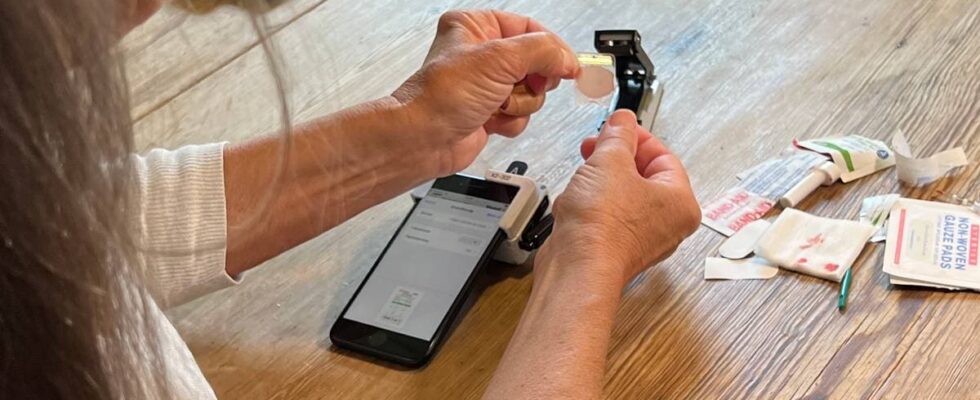The matter in summary: Hjemmelab is a research project under the auspices of Sykehuset Østfold which allows patients to take blood samples at home. Patients take the blood samples by pricking a finger and placing a drop of blood on a small card, which is then inserted into an analysis unit attached to a mobile phone. The results of the blood tests are displayed on the mobile screen within two minutes, and are sent directly to the hospital for assessment by health personnel. The project is still at the test stage, but if it produces good results, it could become a solution for all the hospitals in Health South-East, Health Fonna and Health Stavanger. The solution is the result of a public-private collaboration between Sykehuset Østfold, the biotechnology company Roche Diagnostics and the e-health company Diffia. The general manager of Diffia, Soheil Dabestani, believes that when the solution is ready to be rolled out at scale, it will bring great benefits to healthcare personnel, patients and society as a whole. The summary is made by an AI service from OpenAi. The content is quality assured by news’s journalists before publication. – Sometimes there is fresh blood, while at other times it is a little slow. That’s what Cathrine Schei says, sitting at home in her own living room and about to take the week’s blood test. She pricks a finger and places a drop of blood on a small card. When she was asked to take part in the research project under the auspices of Sykehuset Østfold, the answer was short and unequivocal. – I said yes, I would very much like to take part in this. All for science! Cathrine Schei has a blood disease and must regularly take blood tests Photo: Håkon Hov Martinsen / news Skips long journeys for blood tests For Hjemmelab, as it is called, will be able to save Cathrine Schei and other patients from many trips to the GP or the nearest hospital. Now she inserts the card with blood samples into an analysis unit attached to a mobile phone. Do-it-yourself solution for blood tests. Photo: Håkon Hov Martinsen / news – Now it has finished measuring the HB and now it will be on white blood cells. Two minutes later, the results appear on the mobile screen, and are sent directly to the hospital for assessment by health personnel. Recipients at the other end are the hospital’s record and laboratory systems. Now this is only at the test stage, and Schei still has to travel to a health center for traditional blood tests. Nevertheless, she believes that the blood test app will make everyday life easier. – You may not have to make an extra trip to the health center and sit there in a queue and wait to get in. Patients expect digital solutions. Is this a win-win situation for both patients and hospitals? At Sykehuset Østfold, they believe the answer is yes. Section leader for ICT and innovation at Sykehuset Østfold Jan Terje Dragvoll believes that patients who can take blood tests themselves at home gain more knowledge about their own progress. Section leader for ICT and innovation at Sykehuset Østfold Photo: Håkon Hov Martinsen / news – The patient does not have to spend so much time in the hospital. They are followed up more closely, feel safer and feel better looked after, says Dragvoll. In the first instance, “Hjemmelab” will be tested on ten patients with blood disorders or cancer from Sykehuset Østfold for three months. The hope is that in the future, when this solution is approved, healthcare personnel will be able to receive blood test results “on demand” – without either the patient or the blood having to travel physically. If the testing gives good results, it could become a solution for all the hospitals in Helse Sør-East, Helse Fonna and Helse Stavanger, says Sykehuset Østfold. Can blood tests be taken at the cabin? At Cathrine Schei’s home in Fredrikstad, the test answers come up on her mobile phone. The test answers arrive quickly on mobile. Photo: Håkon Hov Martinsen / news – I think it’s really great. All research that makes everyday life easier and presumably also financially is better for the hospitals, says Cathrine Schei. She also envisions that the solution can be used for travel and holidays. – It is much more practical when you can do it at home. And you can then be at the cabin if you are in Norway – or hopefully you will find out so that you can be at the cabin in Sweden too. I think the solution will bring great benefits. The blood test solution that Schei is helping to test is the first of its kind in Norway, and is the result of a public-private collaboration that has been going on for several years. Østfold Hospital has collaborated with the biotechnology company Roche Diagnostics and the e-health company Diffia. Innovation Norway has contributed funds to the project. Managing director of Diffia, Soheil Dabestani believes they have come up with groundbreaking work on a global level. – Together with Sykehuset Østfold and Roche, we have managed something no one else has done before us: Bring the laboratory to the patient’s home in a safe way, and integrate the entire service with the hospital’s systems and routines. When this is ready to be rolled out on a large scale, it will bring great benefits to healthcare personnel, patients and society as a whole, says Dabestani. Published 31.07.2024, at 19.21
ttn-69
Moving the laboratory to the patient’s home – news Østfold – Local news, TV and radio

